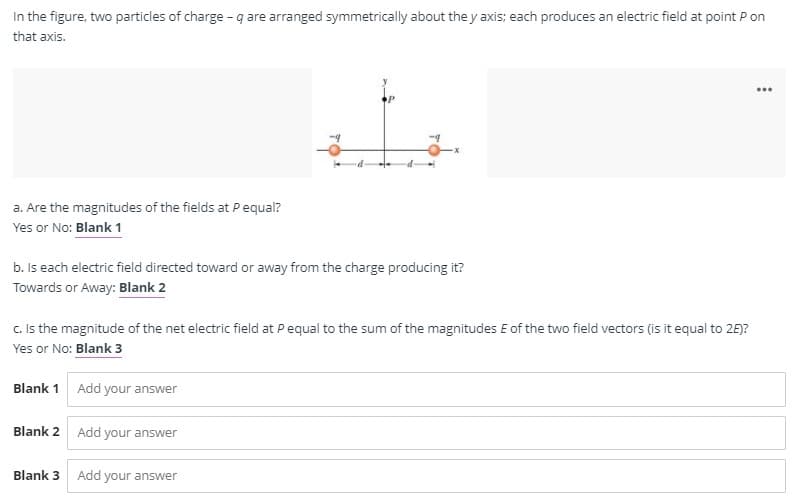rticles of charge – q are arranged symmetrically about the y axis; each produces an electric field at point P on that axis. a. Are the magnitudes of the fields at P equal? (Yes or No) b. Is each electric field directed toward or away from the charge producing it? (Towards or Away) c. Is the magnitude of the net electric field
rticles of charge – q are arranged symmetrically about the y axis; each produces an electric field at point P on that axis. a. Are the magnitudes of the fields at P equal? (Yes or No) b. Is each electric field directed toward or away from the charge producing it? (Towards or Away) c. Is the magnitude of the net electric field
College Physics
10th Edition
ISBN:9781285737027
Author:Raymond A. Serway, Chris Vuille
Publisher:Raymond A. Serway, Chris Vuille
Chapter15: Electric Forces And Electric Fields
Section: Chapter Questions
Problem 24P: (a) Find the magnitude and direction of the electric field at the position of the 2.00 C charge in...
Related questions
Question
In the figure, two particles of charge – q are arranged symmetrically about the y axis; each produces an electric field at point P on that axis.
a. Are the magnitudes of the fields at P equal? (Yes or No)
b. Is each electric field directed toward or away from the charge producing it? (Towards or Away)
c. Is the magnitude of the net electric field at P equal to the sum of the magnitudes E of the two field vectors (is it equal to 2E)? (Yes or No)

Transcribed Image Text:In the figure, two particles of charge - q are arranged symmetrically about the y axis; each produces an electric field at point P on
that axis.
...
a. Are the magnitudes of the fields at P equal?
Yes or No: Blank 1
b. Is each electric field directed toward or away from the charge producing it?
Towards or Away: Blank 2
c. Is the magnitude of the net electric field at Pequal to the sum of the magnitudes E of the two field vectors (is it equal to 26)?
Yes or No: Blank 3
Blank 1 Add your answer
Blank 2 Add your answer
Blank 3
Add
your answer
Expert Solution
This question has been solved!
Explore an expertly crafted, step-by-step solution for a thorough understanding of key concepts.
Step by step
Solved in 5 steps with 1 images

Knowledge Booster
Learn more about
Need a deep-dive on the concept behind this application? Look no further. Learn more about this topic, physics and related others by exploring similar questions and additional content below.Recommended textbooks for you

College Physics
Physics
ISBN:
9781285737027
Author:
Raymond A. Serway, Chris Vuille
Publisher:
Cengage Learning

Principles of Physics: A Calculus-Based Text
Physics
ISBN:
9781133104261
Author:
Raymond A. Serway, John W. Jewett
Publisher:
Cengage Learning

Physics for Scientists and Engineers, Technology …
Physics
ISBN:
9781305116399
Author:
Raymond A. Serway, John W. Jewett
Publisher:
Cengage Learning

College Physics
Physics
ISBN:
9781285737027
Author:
Raymond A. Serway, Chris Vuille
Publisher:
Cengage Learning

Principles of Physics: A Calculus-Based Text
Physics
ISBN:
9781133104261
Author:
Raymond A. Serway, John W. Jewett
Publisher:
Cengage Learning

Physics for Scientists and Engineers, Technology …
Physics
ISBN:
9781305116399
Author:
Raymond A. Serway, John W. Jewett
Publisher:
Cengage Learning

College Physics
Physics
ISBN:
9781305952300
Author:
Raymond A. Serway, Chris Vuille
Publisher:
Cengage Learning

College Physics
Physics
ISBN:
9781938168000
Author:
Paul Peter Urone, Roger Hinrichs
Publisher:
OpenStax College

Physics for Scientists and Engineers: Foundations…
Physics
ISBN:
9781133939146
Author:
Katz, Debora M.
Publisher:
Cengage Learning